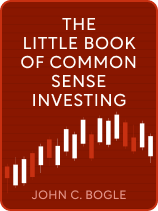

This article is an excerpt from the Shortform book guide to "The Little Book of Common Sense Investing" by John C. Bogle. Shortform has the world's best summaries and analyses of books you should be reading.
Like this article? Sign up for a free trial here.
What is Jack Bogle’s The Little Book of Common Sense Investing about? What’s the key message to take away from the book?
In The Little Book of Common Sense Investing, Jack Bogle outlines the reasons why investors typically make more money with index funds than actively managed mutual funds. Because the costs of mutual funds vastly outstrip those of index funds, Bogle argues that mutual funds deliver reduced returns, and those relative losses compound over time.
Below is a brief overview of The Little Book of Common Sense Investing by John Bogle.
The Little Book of Common Sense Investing
Investing can feel overwhelming. There are various companies vying to manage investors’ money while platforms like Robinhood that encourage expedient day trading entice investors with the possibility of quick profits and beating the market.
Amidst this chaos, The Little Book of Common Sense Investing by Jack Bogle argues that the winning strategy for novice investors is simple: Invest in traditional index funds and hold them indefinitely.
As the founder of the Vanguard Group, one of the world’s largest investment firms, Bogle himself created the world’s first index fund in 1975, which tracked the S&P 500—a stock market index containing stocks of the 500 largest companies in the US. Labeled one of the “four investment giants of the 20th century” by Fortune magazine, Bogle brings his years of experience evaluating investment strategies into this book, which conveys the views that he put into practice for over 50 years.
In this guide, we’ll first introduce the concept of equity investing and clarify the distinctions between index funds and actively managed mutual funds. Next, we’ll discuss areas where mutual funds cost investors more than index funds, followed by statistics showing the higher returns that index funds deliver. Finally, we’ll examine Bogle’s suggestions about incorporating bonds into your portfolio. Throughout this guide, we’ll dig deeper into the data that underlie Bogle’s arguments and examine how the book’s predictions have panned out since its publication.
Introduction to Equity Investing
To begin, we’ll discuss equity more generally—what it is, its role in the US stock market, and how to own it via equity index funds and actively managed mutual funds.
Equity and the US Stock Market
Broadly speaking, equity is the part of a company that belongs to its owners. When companies are publicly traded, investors can acquire partial equity in them by purchasing shares of their stock.
In the US, investors can purchase stocks traded on the US stock market—basically, the market containing all of the US’s publicly traded companies. Consequently, investors gain wealth when stock prices rise and lose wealth when stock prices fall.
According to Bogle, stock market investors earn profit from three factors: dividends, earnings growth, and speculative returns.
1. Dividends are payments that a company makes to its shareholders. For instance, in 2022, the energy company Phillips 66 made quarterly payments of 67 cents per share to shareholders.
2. Earnings growth is the yearly rate of increase in a company’s earnings. Because stock prices reflect earnings growth, companies with higher earnings growth will see their stock price rise more quickly.
3. Speculative returns are the change in stock price caused by investors’ speculation about a company. Bogle measures speculative returns by the price/earnings ratio (P/E)—how many dollars investors are willing to pay for each dollar of a company’s earnings. When P/Es are high, it indicates that speculative returns are also high.
Historically, Bogle observes that the US stock market has grown an average of 9.5% annually since 1900. Of this growth, Bogle notes that 4.4% came from dividends, 4.6% came from earnings growth, and 0.5% came from speculative return.
Index Funds vs. Mutual Funds
To invest in the stock market, index funds are one option available to investors. Put simply, index funds allow investors to purchase portfolios—collections of stocks—that represent large portions of the stock market. In other words, investors can invest money into index funds, which is then used to purchase a portfolio representative of the stock market.
Bogle observes that Traditional Index Funds (TIFs) essentially represent the entire stock market. For example, some TIFs own shares of the entire S&P 500, which tracks the stock performance of the 500 largest companies in the US. Because they represent the entire market, TIFs’ goal is to generate returns in line with the market’s average returns.
Because index funds reflect the stock market’s long-term growth, Bogle notes that investors are supposed to hold them indefinitely. In light of this strategy, index fund managers play a relatively small role and incur fewer fees and commissions.
By contrast, actively managed mutual funds (or “mutual funds,” for short) are overseen by financial managers, assisted by large teams of analysts, who try to beat stock market returns by purchasing and selling stocks at opportune moments.
Because they attempt to outperform the market, mutual fund managers can’t follow the same strategy as index funds, which attempt to generate market-average returns. For one, mutual fund portfolios contain far fewer stocks than index funds. Additionally, because mutual fund managers are constantly purchasing and selling stocks, Bogle observes that mutual funds have much greater portfolio turnover than index funds.
The Problem With Mutual Funds: Everyone Can’t Win
Although mutual funds attempt to beat the market average, Bogle notes that doing so is a zero-sum game: For every investor whose returns are above-average, there must be another whose returns are below-average. After all, it’s mathematically impossible for everyone to enjoy above-average returns.
Furthermore, as we’ll discuss in the next section, mutual funds have much higher costs than index funds. So, after deducting the costs of investing, this zero-sum game becomes a loser’s game: Because the average investor’s gross returns (their returns before deducting investment costs) match the market average, the additional costs of investing cause investors’ net returns (their actual returns minus investment costs) to fall below market average. So, funds with the highest investing costs typically fall furthest below the market average.
Why Mutual Funds Cost Investors More Than Index Funds
Since index funds are typically held indefinitely, while mutual funds are actively managed, Bogle claims that index funds are much more cost-effective for investors. In this section, we’ll examine three areas where mutual funds cost more than index funds: expense ratios, sales charges, and portfolio turnover.
Cost 1: Expense Ratios
Mutual funds and index funds alike have expense ratios—the percentage of the fund’s assets that goes to operating expenses, like marketing, administration, and portfolio management. Because they require active intervention, Bogle claims that mutual funds’ expense ratios are substantially higher than those of index funds.
In particular, Bogle asserts that the average mutual fund’s expense ratio is about 1.3% annually. So, if a mutual fund had $100 million in assets, $1.3 million is dedicated to operating expenses—leaving $98.7 million to actually invest. Conversely, the TIF’s average expense ratio is about 0.1% annually. So, if the TIF had $100 million in assets, only $100,000 would be dedicated to operating expenses, leaving $99.9 million to invest. This means that about 1.3% of the average mutual fund investor’s assets, compared to 0.1% of the average index fund investor’s assets, is deducted for operating expenses.
Bogle concedes that not all mutual funds are created equal. For example, between 1991 and 2016, mutual funds in the lowest-cost decile had expense ratios of 0.32%. On the other hand, mutual funds in the highest-cost decile had expense ratios of 2.4%. Still, while there’s variance in mutual funds’ expense ratios, TIFs have lower expense ratios than mutual funds across the board.
Cost 2: Sales Loads
In addition to higher expense ratios, mutual funds also often have sales loads—charges that investors pay to agents who sell the mutual funds. Though Bogle doesn’t provide exact data, he estimates that sales loads can easily cost mutual fund investors 0.5% per year. This means that if you invest $100,000 in a mutual fund over a year, $500 would be deducted as a sales charge—even if your stocks decreased.
By contrast, TIFs typically don’t have any sales loads. So, while many mutual fund investors spend around 0.5% of their assets on sales loads each year, investors in index funds aren’t saddled with these costs.
Cost 3: Portfolio Turnover
Another difference between mutual funds and index funds is portfolio turnover—basically, the ratio of a portfolio’s total assets to its total purchases and sales. Because higher portfolio turnover creates more fees, such as commissions to stockbrokers, Bogle claims that mutual funds cost investors more money due to their higher turnover rates.
In particular, Bogle suggests that turnover costs are approximately 1% of turnover rate. To illustrate, a mutual fund with 40% turnover would cost investors about 0.4% in associated fees. Moreover, Bogle observes that in 2016, sales and purchases within mutual funds totaled $6.6 trillion, or 78% of the total $8.4 trillion in mutual fund assets. Consequently, he concludes that the average mutual fund costs another 0.78% to its investors.
By contrast, because index funds are held indefinitely, they have little-to-no turnover costs. In fact, Bogle states that the TIF’s annual portfolio turnover is about 3%, costing investors a minuscule 0.03% of their assets.
The Hidden Cost of Taxes
In addition to turnover fees, Bogle also argues that mutual funds lose more money to taxes because of their high turnover rates.
Mutual funds are tax-inefficient, Bogle claims, because stocks held for less than a year are considered short-term gains. Further, because short-term gains are susceptible to personal income tax, mutual funds with high turnover rates can leave investors on the hook for personal income tax—up to 37% for the highest tax bracket.
Profit from index funds, on the other hand, is considered a long-term gain, since index funds are normally held for longer than a year. Consequently, index fund investors only pay a capital gains tax, which is normally 15%. So, Bogle concludes that mutual funds cost investors more in taxes than index funds.
How Index Funds Statistically Outperform Mutual Funds
Despite their higher costs, mutual funds could nonetheless be superior to index funds if they generated proportionately higher returns. In this section, however, we’ll examine Bogle’s arguments to the contrary: Mutual funds generate significantly lower returns for investors than index funds.
Historical Data
First, Bogle examines historical data to see whether mutual funds have outperformed index funds in the past. In this regard, the data are clear: Low-cost index funds have consistently outperformed the vast majority of mutual funds since 1970.
To show as much, Bogle turns to the records of the 355 mutual funds that existed between 1970 and 2016. Of these 355 funds, 281 of them—about 80%—are no longer in business. Because you can’t invest for the long term in funds that don’t exist for the long term, Bogle concludes that low-cost index funds—which don’t go out of business—have been superior to these 281 funds.
Of the 74 remaining funds, Bogle notes that 29 of them significantly underperformed relative to the market, with returns that were more than 1% below the S&P 500’s returns. Moreover, 35 of those funds essentially matched the market average, with returns that were within 1% of the S&P 500 in either direction.
Consequently, Bogle concludes that only 10 of the original 355 funds in 1970 outperformed the S&P 500 by over 1%. In other words, only 3% of the mutual funds that existed since 1970 delivered clearly above-market returns.
(Shortform note: Since The Little Book of Common Sense Investing’s publication in 2017, the historical trend of mutual funds underperforming has continued. Indeed, a 2022 study from the S&P Dow Jones Indices found that no actively managed funds consistently beat the market from 2017 to 2022.)
The TIF, conversely, delivered returns that were only 0.1% below the market average—a result of its substantially lower operating costs. So, the TIF delivered returns equal to or greater than 97% of mutual funds since 1970. Rather than searching for the few high-performing mutual funds, Bogle concludes that investing in index funds is the superior strategy.
Compound Interest
Moreover, Bogle notes that these small differences in returns between mutual funds and index funds yield outsized long-term results because interest compounds over time—in other words, it grows exponentially instead of linearly.
To see the effects of compound interest, imagine two funds: a mutual fund that earns 8% annually, and an index fund that earns 9% annually. If you initially invested $100,000 in each fund, they would deliver the following returns over time:
- After one year, the mutual fund would return $108,000, while the index fund would return $109,000.
- After 10 years, the mutual fund would return $216,000, while the index fund would return $237,000.
- After 50 years, the mutual fund would return about $4.7 million, while the index fund would return over $7.4 million
So, while a 1% difference would only cost you $1,000 after the first year, it would cost you over $2.7 million after fifty years!
Monte Carlo Simulation
Beyond historical data, Bogle also uses a Monte Carlo simulation—a statistical model predicting how likely different outcomes are—to determine the likelihood that actively managed mutual funds will outperform TIFs in the long term. Mirroring the historical data, this simulation predicts that only 2% of mutual funds will outperform index funds over a 50-year period.
Bogle’s Monte Carlo simulation relies on two key assumptions: First, mutual funds are volatile, meaning their performance relative to the market varies yearly; and second, mutual fund management will cost about 2% annually, while index fund management will cost 0.25%. Because TIFs actually cost about 0.1% annually, while mutual fund costs can run north of 2%, Bogle observes that this simulation gives mutual funds the benefit of the doubt.
Given these assumptions, the simulation predicts that after one year, 29% of actively managed mutual funds would beat index funds. However, after five years, only 15% of mutual funds would beat index funds, and after 50 years, only 2% of mutual funds would outperform index funds.
Reversion to the Mean
According to Bogle, fewer mutual funds outperform index funds over time because of reversion to the mean—the statistical tendency for assets to converge to the average price over time. Because of reversion to the mean, mutual funds that initially outperform index funds are likely to see returns drop below index funds’ returns in the long run.
For example, imagine that you flip a coin five times and it lands on heads four times—80% of the time. While this result is unsurprising in the short term, if you kept flipping the coin—say, 100 times—you’d expect the frequency to level out to about 50%.
Similarly, while a sizable percentage of mutual funds can beat index funds in the short term, few mutual funds can sustain this performance for the long term. Just like you shouldn’t expect a coin to keep landing on heads 80% of the time, the Monte Carlo simulation shows that you shouldn’t expect mutual funds to keep outperforming index funds in the long run.
Future Projections
Beyond the Monte Carlo simulation, Bogle also makes specific projections about the future prospects of mutual funds versus index funds, from 2017-2027. Due to lower dividends, lower rate of gross domestic product (GDP) growth, and lower speculative returns in the current market conditions, he predicts the gap between index fund returns and mutual fund returns will increase in the future, with index funds increasingly outperforming mutual funds.
To make his predictions, Bogle analyzes the three factors that contribute to stock prices: dividends, earnings growth, and speculative returns. First, Bogle notes that in 2017, the average dividend yield—the ratio of a company’s dividends per share compared to its share price—was lower than the historical average. Indeed, the dividend yield in 2017 was 2%, far below the historical average of 4.4%. Consequently, if you owned stock in a company at $100 per share, you could expect $2 in annual dividends per share.
(Shortform note: Since Bogle published The Little Book of Common Sense Investing in 2017, the S&P 500’s average dividend yield has dropped further; as of 2023, it sits at 1.68%, though in 2021 it dropped as low as 1.29%. So, this particular aspect of stock returns is even lower than Bogle predicted thus far.)
Second, Bogle notes that earnings growth is correlated strongly with GDP—the total value of goods and services in a given society. And although the US’s GDP has historically increased about 6% annually, projections suggest it will increase at a slower rate of 4 to 5% annually from 2017-2027. To be cautious, Bogle assumes earnings growth will increase about 4% annually.
Finally, Bogle agrees with Wall Street projections that P/Es—price-to-earnings ratios indicating how much investors would pay per dollar of earnings growth, which are the best proxy for speculative returns—will decrease from 23.7 in 2017 to about 20 in 2027. This decrease, he asserts, would lead to a 2% drop in speculative returns.
Considering these factors, Bogle predicts that the average market return will be about 4% in 2017 through 2027: 2% from dividends, 4% from earnings growth, and -2% from lower speculative returns. This falls well short of the market’s average return of 9.5% since 1900.
However, this 4% market return ignores two costs: inflation, and the costs of investing in mutual funds versus index funds. Inflation, Bogle assumes, will continue to rise about 2% annually, meaning the 4% market return will amount to 2% in real value. Additionally, Bogle assumes that actively managed mutual funds will cost 1.5% annually, while low-cost index funds cost about 0.1% annually.
Consequently, we can actually expect mutual funds to return about 0.5% annually, and low-cost index funds to return about 1.9% annually. To recap:
Average market return: 4% → Adjusted for inflation: 2%
Mutual fund: (2% market return) – (1.5% annual costs) = 0.5% annual return
Index fund: (2% market return) – (0.1% annual costs) = 1.9% annual return
In other words, index funds will yield nearly four times greater annual returns than mutual funds from 2017 to 2027.
Bonds and Asset Allocation
While Bogle primarily discusses equity investments, he also discusses bonds—loans that investors pay to governments or corporations in exchange for interest over time. For example, if you purchase a $1,000 10-year Treasury bond at 3% interest, the Treasury agrees to pay you $30 annually the next 10 years, and also repay the $1,000 principal in 10 years.
Because their returns are less volatile than returns on equity, Bogle argues that bonds belong in your investment portfolio. In this section, we’ll discuss Bogle’s reasons for investing in bonds, why he favors bond index funds to bond mutual funds, and his suggested investment ratio of equity to bonds.
Bonds vs. Equity
To begin, Bogle concedes that equity investments, or stocks, have historically generated greater returns than bonds: Annual returns on bonds have been 5.3% since 1900, while annual returns on stocks have been 9.5%. Nonetheless, he claims you should invest in bonds for three reasons: Bonds can beat stocks over short stretches; bonds provide protection during market drops; and bond yields are still greater than current dividend yields.
First, Bogle observes that from 1900 to 2017, bonds outperformed stocks in 42 of those years. So, in years when the stock market’s returns are below average, bonds can offer a better return on investment.
Second, because bond returns are largely fixed by bond interest rates, Bogle notes that they’re much less volatile than stocks. For example, while nobody can guarantee Apple’s stock returns from year to year, a one-year Treasury bond at 4% interest effectively guarantees a 4% return on your investment. Consequently, bonds can stabilize your investment portfolio amidst the stock market’s ebbs and flows.
Finally, Bogle points out that in 2017, bond yields (the annual return on bonds relative to their price) remained higher than stocks’ dividend yields: The average bond yield was 3.1%, while the average dividend yield was 2.0%. So, bonds can generate a greater flow of liquid income than stocks.
Bond Mutual Funds vs. Bond Index Funds
Just like you can purchase equity via actively managed mutual funds and index funds, you can also purchase bonds via bond mutual funds and bond index funds. In the case of bond mutual funds, managers actively purchase and sell bonds using fund assets, whereas bond index funds purchase bonds that reflect certain bond indices. Because bond index funds are more cost-efficient, Bogle argues that they deliver better returns than bond mutual funds.
To defend this claim, Bogle examines the two primary types of bond funds—government and corporate bonds—in addition to three maturity segments—short-term, intermediate-term, and long-term. Further, he uses SPIVA to compare bond mutual funds in these six cross-sections to similar bond index funds.
From 2001 to 2016, SPIVA demonstrates that 85% of bond indices outperformed similar bond mutual funds. In particular, long-term bond indices outperformed 97% of long-term bond mutual funds, both in government and corporate segments.
According to Bogle, bond index funds are a better investment than bond mutual funds for the same reason that equity index funds outperform equity mutual funds: They have lower expense ratios. The average bond index fund’s expense ratio was 0.1% annually, while the average bond mutual fund’s expense ratio was 0.75% annually.
The Ratio of Equity to Bonds
Beyond arguing that you should invest in bonds, Bogle also considers the ideal ratio of equity to bonds in your portfolio. He concludes that the ideal ratio of equity to bonds depends on your financial position and your personal degree of risk aversion.
To start, Bogle cites Benjamin Graham’s advice in The Intelligent Investor that your portfolio should be split 50-50 between stocks and bonds. Although Bogle considers this a good starting point, he argues that it’s too rigid: Certain investors should incur more risk, investing more in stocks, while other investors should incur less risk, investing more in bonds.
Bogle argues that your financial position affects your ability to take risks. For example, those with financial liabilities looming in the near future—like purchasing a home, or paying to raise a child—should be less risky with their investments. After all, if they’ve only invested in stocks, then they might not be able to cover these liabilities if the market crashes. By contrast, investors with fewer liabilities can afford a riskier allocation of stocks to bonds.
Beyond financial position, Bogle argues that your personal preferences for risk aversion should affect your asset allocation. For example, if the ebbs and flows of the market cause you extreme stress about potentially losing money, then your portfolio should contain fewer stocks and more bonds. On the other hand, investors comfortable with greater risk to earn higher returns should have a higher ratio of stocks to bonds in their portfolios.
More generally, Bogle advises that your ratio of stocks to bonds should be as high as your financial position and risk aversion allows. For example, he counsels an 80-20 split of stocks to bonds for young investors with low risk aversion who want to grow their wealth. Conversely, for retirees whose portfolios fund their retirement, Bogle counsels a 25-75 split. Because retirees are more concerned with short-term stability than long-term growth, they benefit from the stability of bonds rather than stocks.

———End of Preview———
Like what you just read? Read the rest of the world's best book summary and analysis of John C. Bogle's "The Little Book of Common Sense Investing" at Shortform.
Here's what you'll find in our full The Little Book of Common Sense Investing summary:
- A simple winning strategy for novice investors
- Why index funds are superior to mutual funds
- Why bonds belong in your investment portfolio






